Indigenous Anglicans from four nations came together on pilgrimage to share faith, culture, and stories that strengthen and sustain their communities. From July 31st to August 10, 2025, thirty indigenous pilgrims from Aotearoa, Canada, Brazil and the U.S. explored the Mihinaretanga and cultures of the Diné (Navajo Nation) and Pueblo peoples.
The haerenga (pilgrimage) emerged from conversations among a circle of friends between the Most Reverend Dr Don Tamihere (Aotearoa NZ), the Reverend Canon Cornelia Eaton (Navajoland, U.S.), the Most Reverend Chris Harper (Canada), the Most Reverend Marinez Bassotto (Brazil), the Reverend Canon Robert Two Bulls (U.S.) and the Right Reverend Daniel Gutiérrez (U.S) in 2024, about what it might mean for indigenous Anglicans to come together to walk in faith, celebrate achievements, preserve culture and language, strengthen the stories that unite communities, and lift each other up so that their communities may flourish.
For the Episcopal Church in Navajoland, one of the most significant milestones had just taken place in June 2025: after forty years as an area mission, it had become a missionary diocese. The visit was therefore not only a pilgrimage but also a celebration for the global indigenous communion.
Haerenga Across Five Destinations
The haerenga spanned five destinations: Window Rock (Arizona), Bluff (Utah), and Farmington, Albuquerque and Santa Fe (New Mexico), exploring church missions, native museums, participating in dawn ceremonies and services, community dinners, indigenous markets places, traditional dance and culturally sacred sites.
For Archbishop Don, “Haerenga or pilgrimages are nothing new for indigenous peoples. Our tūpuna walked great distances, just as Ihu Karaiti and his disciples did. This circle of friends committed to helping one another, shaped by the experience of colonised Indigenous peoples whose dignity has historically been denied in wider society, with little to no authority and jurisdiction within church structures, are now working together towards self-determination.”
This pilgrimage is a pathway for mihinare to encounter Christ through other indigenous expressions of Anglicanism through a strong programme developed by Rev. Cn Cornelia and Bishop Daniel Gutiérrez.
Te Pīhopatanga o Aotearoa guided 23 Māori pilgrims from its various Hui Amorangi across international waters, three states and five destinations. The team’s coordination ranged from weaving natural connection points into the programme such as services and communal meals, to managing the complex logistics of flights, car rentals, and accommodation. This haerenga followed a pilgrimage earlier in 2025, where they hosted the Compass Rose Society throughout Aotearoa and Fiji.
Navajoland 1-8 August 2025
From August 1 to 8, Rev. Cn Cornelia welcomed the pilgrims to Navajoland, the homeland of the Navajo Nation in the Southwestern United States. Spanning 27,000 square miles across three states, Navajoland is home to nearly 400,000 citizens (2021 census).
Rev. Cn Cornelia describes the Diné as a people of Hózhǫ́, a sacred way of harmony and balance that grounds them in relationship with the Creator and the holy people. Offering a bridge to the stories and traditions of Indigenous communities throughout the Communion.
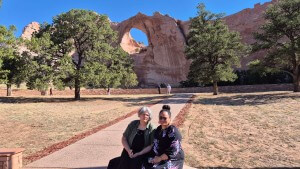
Huia Tahere and Larissa Ruru at Window Rock
Window Rock, Arizona | August 1 – 3
This leg began with visits to Navajo Nation Museum, St Mark’s Coalmine, Good Shephard Mission and Canyon de Chelly National Monument.
The sacred site of Canyon de Chelly National Monument was a significant spiritual visit. It consists of three major canyons covering 131sq miles. Diné families have been living there for nearly 5,000 years.
Canyon de Chelly was once a thriving homeland, where the Diné farmed, raised and herd livestock, sheep and cattle, and lived in the shelter of its red cliffs. In 1864 the U.S. Army dammed the river, starved the people, and forced more than 10,000 on the ‘Long Walk’ to Fort Sumner. Their moccasins wore thin, thousands lost their lives, yet they carried their songs.
Rev. Cathlena Plummer, daughter of the late Bishop Steven Plummer, accompanied the pilgrims and called this “the holiest of holy places.” Her father had stood before 800 people when he was ordained here, and each time she returns, she feels the warmth of that moment.
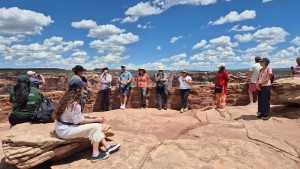
Canyon de Chelly National Monument
At Spider Rock, one of the tallest and thinnest formations in the valley, the Diné tell how Spiderwoman weaves sacred patterns that she continues to gift to her people. They honour her with offerings of corn pollen, and today men and women weave beauty, grief, and survival into their art.
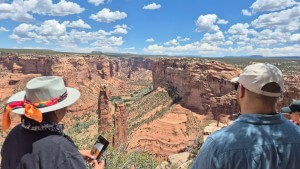
Looking down at Spider Rock
Here, Rev. Cn Cornelia invited the pilgrims to pause and let the land speak, to listen to the wind moving through the crevices, to find shelter in the dark clouds, and to hear the cry of the crows. Later, the pilgrims joined together to sing the Lord’s Prayer in their native languages.
At the Good Shepherd community dinner, pilgrims made Navajo fry bread from corn flour to compliment the hot stews and salads. For Māori, used to wheat flour fry bread, it was both familiar and new.
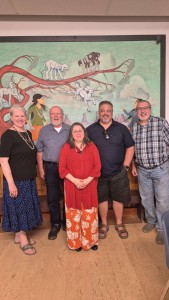
(L-R) Bishop Riscylla, Bishop Barry, Archbishop Don, Archbishop Chris
Archbishop Don spoke about a photo shown to him earlier that day, “In 1991, Archbishop Whakahuihui Vercoe of Aotearoa stood with Bishop Steven Plummer of the Navajo, and beside them was young Cathlena [Plummer], just eleven years old. That photo captured more than a moment, it carried a vision of what it could mean to be truly Indigenous Anglicans in our own lands. I was told your father was inspired by that visit, and he dreamed that one day Navajoland would become a diocese in its own right. Today, we follow in the footsteps of those ancestors.
“At General Convention last year, we witnessed the motion to establish a missionary diocese for Navajoland, and I was also here among you as you prepared for that step. This is part of our culture—we do not only send thoughts and prayers, we turn up, we walk among you. That is why Cornelia and I, and others with us, were so eager to make this haerenga happen. And so here you see our brothers and sisters from Canada, from Brazil, from South America, and from Aotearoa. We stand together as one Indigenous family.
“Jesus was not English, he never spoke English. The Scriptures he read were the words of his ancestors—their proverbs, their songs, their stories. Just like you, just like us. That is why we are here: to encourage, to celebrate, and to remind you that your family is far bigger than you imagined. Across the world you have Indigenous brothers and sisters who walk with you, and we came in person so you would know that truth.”
Before Archbishop Chris Harper left the pilgrimage with Bishop Riscylla Walsh Shaw and Ven. Rosalyn Kantlaht’ant Elm to lead Sacred Circle in Canada, he reflected at the community dinner, “We seek a process of healing, not only for our own brokenness, but as a resilient people with a common story and common songs. We use the word maamawi—walking together—so we may see Christ in one another and bring a message of peace, where the whole church walks in healing and love.”
The Good Shepherd Mission
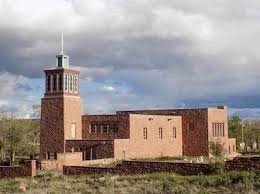
The Good Shepherd Mission, part of the Episcopal Church in Navajoland, was founded in the 1880s as a medical mission and today spans 50 acres with historic buildings, a pink-stone church, and a permaculture garden using Navajo techniques. Rooted in the Episcopal tradition and enriched by Navajo spirituality, it is home to a devoted community and a destination for mission groups.
Eucharist service on Sunday was led by a ministry team of Bishop Barry Beisner, Rev. Leon Sampson, Rev. Cathlena Plummer, and Rev. Cn. Cornelia, who together offered the sacrament and prayers.
In his kauhau, Rev. Leon reflected on seminary days when he was asked to write about how his community, congregations, and the Navajo faith tradition could be understood through theology. Drawing on Carl Barlow’s idea of “nothingness,” where evil is empty and without substance, he noted that moving forward means recognising its presence and choosing good instead of what leads nowhere. With humour, he recalled visiting Duck Donuts each Sunday for coffee and a maple-glazed bacon donut, seeing even such simple choices as reminders of what we embrace and what we resist.
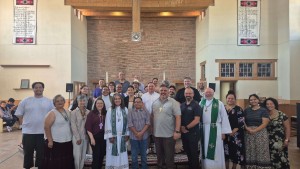
Pilgrims with the ministry team
Bluff, Utah | August 3 – 6
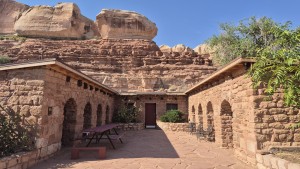
In 1943, Father Harold Liebler founded St. Christopher’s Mission after studying Navajo language and customs to connect with the Diné. He purchased an old trading post, and the mission soon opened the area’s only school, later repurposed as a chapel, and a hospital. The mission soon focused solely on church life in the Episcopal Church in Navajoland.

Welcomed inside the hogan styled church at St Christopher’s
Rev. Paula Henson led the welcome ceremony placing sacred stones in the centre of the church for the four directions of the mountains—Blanca Peak (east, white shell, new birth), Mount Taylor (south, turquoise, life), San Francisco Peaks (west, abalone, sustenance), and Mount Hesperus (north, jet, endurance). She taught that one exits a hogan by walking clockwise toward the east, then touched the stones saying, “we are now related,” inviting pilgrims into a circle of story, blessing, and healing.

The dawn pollen ceremony
The next morning, the pilgrims gathered for a dawn pollen ceremony. They were invited to choose between yellow pollen from female corn and white pollen from male corn, each symbolising balance and harmony. Facing east, they offered this blessing to welcome the rising sun.
Deep in the desert, along a dirt road, the pilgrims reached St. Mary’s of the Moonlight, a remote outpost started by Father Liebler and local Diné. He moved there after a fire burnt down the original St Christopher’s chapel.
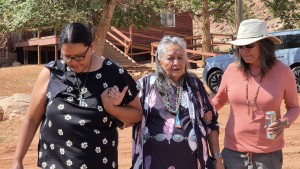
Rev. Cathlena, Rev. Catherine and Rev. Cn Cornelia
Rev. Catherine Plummer and her brother, Walter Shorty, welcomed the pilgrims on arrival. Catherine recalled attending St. Christopher’s from age five, crossing the river from her family’s land where she tended sheep, and learning English from Father Liebler, who ran the school. She was ordained there, later marrying Steven Plummer in 1977, before he became Bishop. She was unable to continue ministering with him because their church canons allow only one priest to serve in a parish.
Walter Shorty singing a himene
Inside the hogan, Walter shared its story: shaped like an upside-down eagle’s nest, built after a man asked the eagle how to create a permanent home for women, crafted from cedar for durability and bark for insulation.
Walter explained the Navajo naming traditions and the story behind his own name. In 1837, names were needed for the first census. The Navajo people did not use personal names at that time, instead they were identified by the qualities or characteristics that best described them.
Walter and Catherine’s father was referred to “the man with the white horse,” a name later shortened to White Horse. His father before him was known as the short man from Grey Mountain, from which the family name Shorty came. Walter closed the visit with a song, praying, “Creator, you are here with us on earth, bless us.”
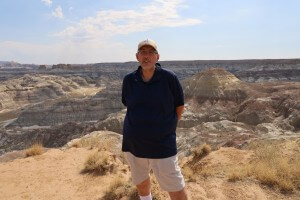
Pilgrim Tim Quayle
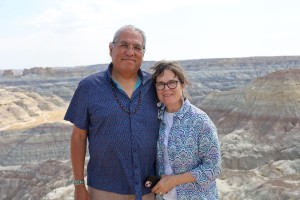
Pilgrims Rev. Cn Robert and Ritchie Two Bulls
The final stop was St John the Baptizer Church led by Rev. Paula Henson, the Priest-in-Charge. Established in 1946 by Father Liebler, the mission began in what was once a trading post. Though weathered with age, the parish works hard to maintain it, with women raising funds through patchwork, bible studies, and community projects for supplies, flooring, and even video equipment.
They gather to practice songs and hold healing ceremonies, often translating the Navajo Bible into English for younger families who no longer speak the language fluently. While most still speak Navajo there, they note that the King James Bible was translated into an older form of Navajo by a Franciscan priest in the 1920s, which differs from the dialects spoken today. Many also prefer to call themselves Diné, as “Navajo” was a name given from outside.
Farmington, New Mexico | August 6 – 8
The final stage of the Navajoland journey brought the pilgrims to Rev. Cn. Cornelia’s home parishes, St. Michael’s, Upper Frutiland, All Saints, Farmington. They visited St Luke’s in the Desert Episcopal Church to hear from the elders. At St. Michael’s Church, Rev. Cn. Cornelia highlighted the Diné artwork decorating the Church, including a Diné Jesus depicted behind the altar.
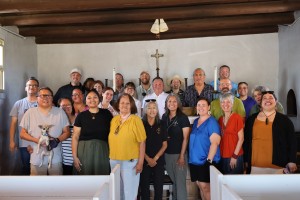
St Luke’s Episcopal Church
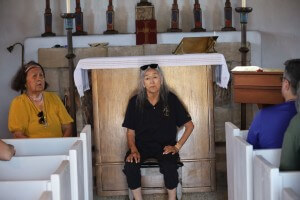
They toured Rev. Cn Cornelia’s family Mason Sheep Camp. After inspecting the sheep, the site visit concluded in her family’s female hogan, a hexagon-shaped dwelling used for ceremony and shelter, with its doorway facing east. She began giving thanks to each mountain and finishing facing the eastern doorway so that the stories are not kept inside. Then led a smoke ceremony to bless each pilgrim. The tobacco used was gathered from each of the four sacred mountains.

Rev. Cornelia showing the indigenous artwork in her church
Much of their stay unfolded within the walls of All Saints Episcopal Church and the Hózhó Wellness Center. Once an old hospital, the center has for more than a century cared for the Navajo people. It offers support, spiritual wellness, and classes from parenting, cooking, art, addiction recovery awareness and Navajo storytelling. It is also used for their Feeding Programme, delivering food to the community.
A community dinner marked the final evening, bringing the two Indigenous communities together to break bread, give thanks, perform song and dances, and deepen their sense of kinship.
Pueblo Peoples, New Mexico | August 8 – 10
Alburquerque and Santa Fe
Bishop Daniel Gutiérrez, together with Canon Doug Horner and Rev. James Stambaugh, hosted the pilgrims in Alburquerque and Santa Fe.
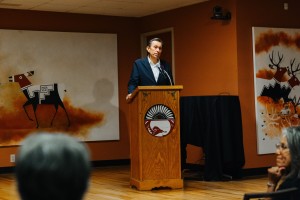
Bishop Daniel Gutiérrez welcoming guests and friends to dinner
They were welcomed to the Indian Pueblo Cultural Center by its first native CEO, Monique Fragua. The center offers an experience into the 19 Pueblo tribes with a historic museum, artworks, culture shows, dining and accommodation. Pilgrims were given a guided tour through the museum. As in Māori tradition, Pueblo stories tell of God giving the breath of life to humanity, but in their account, it was women who were created first.
Debra Anne Haaland, former U.S. Secretary of Interior under the Biden administration, and the first Native American to serve in that role, gave remarks at the Indian Pueblo Cultural Center where she shared her own story and encouraged young Indigenous people to step into leadership and active political participation.
Bishop Daniel opened the dinner with words of welcome, speaking of his friendship with Archbishop Don. He noted his regret at not being able to attend the Compass Rose Pilgrimage in Aotearoa. He had invited colleagues from the Hāhi, clergy and laity alike, along with close friends, many of whom spoke about the depth of their enduring ties to Bishop Daniel.

Bishop Andrew, Bishop Daniel and Archbishop Don
Just a short walk from the Santa Fe Plaza, the Church of the Holy Faith, founded in 1863, stands as one of New Mexico’s oldest Episcopal parishes, its adobe walls and stained-glass bearing witness to more than a century of history and tradition in the heart of downtown. Here the pilgrims heard from former U.S. Ambassador to New Zealand, Tom Udall, and his wife, Jill, who spoke warmly of their years in Aotearoa and their collaboration with Māori artists. Afterwards, the group explored Santa Fe itself, moving between its elegant shops and lively street markets.
They visited El Santuario de Chimayó, built in the early 19th century, stands on land long held sacred by Pueblo peoples for its healing springs and earth. Today it is a Roman Catholic church and major pilgrimage site, renowned for its adobe architecture and tierra bendita (holy earth) believed to carry healing power.
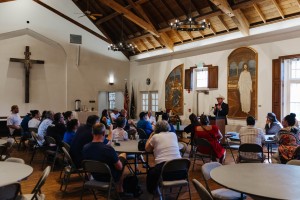
Former US Ambassador to NZ, Tom Udall, speaking to the pilgrims
The haerenga revealed the shared cultural and spiritual bonds that connect Indigenous churches across the Anglican Communion. These enduring partnerships, kinship ties, and global relationships remain central to their flourishing.
Hosted with generosity by Rev. Canon Cornelia Eaton, Bishop Daniel Gutiérrez and Archbishop Don Tamihere, the pilgrimage strengthened ties with the new Diocese of Navajoland, uplifted communities, and opened space to imagine new possibilities.
